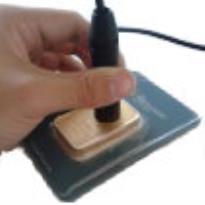Product Details
Testing - ID 280
-
Bullion Purity ECM Check
Minimum SGD 55 per session0 gram (0 oz)
Minimum SGD 55 per session-
Any Quantity:Any2.20 SGD
-
Bullion Purity ECM Check
ECM Checks are a quick method to reliably check for inhomogeneity (inserts) across a large number of coins or bars in a very inexpensive and fast manner. Through ECM we can offer walk-in customers a quicker alternative to a full DUX test. Please note that an ECM Check does not come with a test report, tamper proof seals or online verification which are included as part of a full DUX Test. ECM can pass through thin plastic allowinging checks on some packaged bullion.
Each item tested in an ECM test would be charged SGD 2.20 with a minimum SGD 55 charge per session.
A typycal scenario might be a customer who buys bullion from a third party in the secondary market and comes with the third party to check the bullion prior to purchase.
ABOUT ECM
Since January 2013, we have been studying the feasibility of authenticating small to medium sized bullion items by measuring their electrical conductivity value. Fast forward to December 2013, we have incorporated electrical conductivity measurement into our non-destructive testing methodology for bullion. It is a simple yet powerful way to detect for inhomogenity or inserts present within the bullion item. Electrical conductivity measurement offers a faster and more possibly more reliable test alternative to ultrasonics to detect for inhomogenity within a bullion item. Here is why:
1. Testing electrical conductivity is perfect for authenticating silver
Because silver is the most conductive element in existence, no other metals can be used to fake silver. Even if people try to mix and match metals and substances to form different alloys, it will be almost impossible to match the conductivity of pure silver because alloying a pure metal will cause its conductivity to decrease. In short, it is theoretically and practically IMPOSSIBLE to have a metal or an alloy to match the electrical conductivity of pure .999 fine silver!
For gold, it might be theoretically to mix and match metals to obtain an alloy to match the electrical conductivity of gold, but it would not be possible to have an alloy that matches both the electrical conductivity AND the density of gold. Therefore, measuring the electrical conductivity as well as the density of the bullion is a truly definitive non-destructive test to authenticate pure gold.
2. Tolerances are up to 16 times stricter than compared to ultrasonics
In-house statistical studies have shown that the tolerances obtained from electrical conductivity measurements are up to 16 times tighter compared to readings obtained from ultrasonic measurements. This makes our testing methodology much more reliable and sensitive (see point 3 on sensitivity).
3. Gold and silver are extremely sensitive to impurities
A presence of small amounts of impurities can greatly affect the electrical conductivity of gold and silver. For example, from the chart below, we can see that the electrical conductivity of pure gold is at 45 MS/m. Ducat is a gold coin with 1.6% copper impurity. As seen from the chart, a mere 1.6% of impurity lowers its electrical conductivity to 25.3 MS/m. That’s more than a 40% reduction in electrical conductivity.
4. Able to test through plastic sheaths
The ability for our instrument to take readings through plastic sheaths means a lot to us because gold bullion from many major brands come packaged in plastic sheaths containing the mint’s assay certificates and labelled with their serial numbers. Removing the plastic sheaths to perform an ultrasonics test would mean destroying the mint assay certificate that comes along with the gold bullion, potentially affecting the salability of the item.
